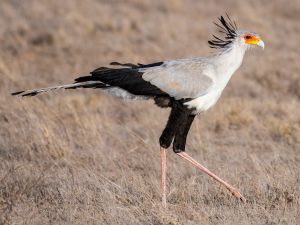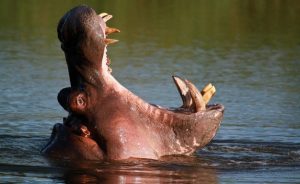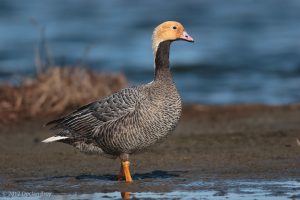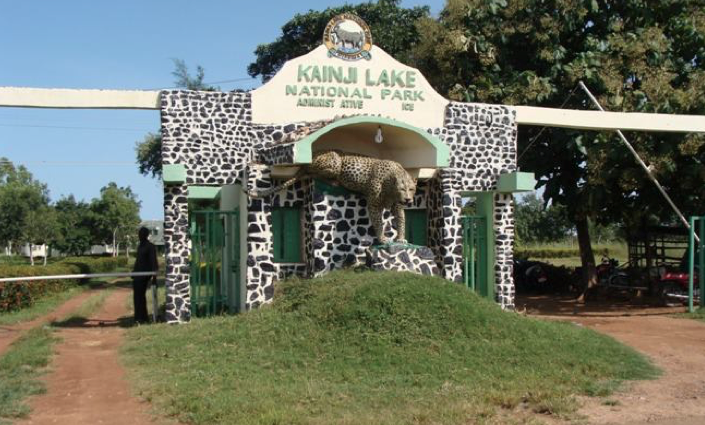Kainji National Park, one of Nigeria’s most famous national parks, is situated in Niger State and Kwara State. Established in 1978, it spans approximately 5,341 km² (2,062 sq mi) and comprises three distinct sectors: part of the Kainji Lake, the Borgu game reserve, and the Zugurma game reserve. This park serves as a major centre for wildlife conservation and is a popular destination for ecotourism in Nigeria.
The park features round hills, expansive pediments/plains stretching between the hills, and incised river channels that gradually decline into the River Niger valley. The wildlife includes elephants, lions, buffaloes, antelopes, hippos, Patas monkeys, Nile crocodiles, leopards, hyenas, bushbucks, and many more. Additionally, around 180 bird species have been documented, including Secretary Birds, Ground Hornbills, and Great White Pelicans.

Overview
Borgu and Zugurma game reserves form the Kainji Lake National Park (KLNP), Nigeria’s first national park, created in 1978. Covering 5,340 square kilometres with a diameter of 31 kilometres and an area of 2,062 square miles (82 square kilometres), it is located between latitudes 9°40’N – 10°30’N and longitudes 3°30’E – 5°50’E, about 500 kilometres from Lagos and 385 kilometres northeast of Abuja.
The park is divided into three sectors, which include important tourist attractions such as the Zugurma Game Reserve, the Borgu Game Reserve, and Kainji Lake. The park is managed by the Federal National Park Service (FNPS) and receives direct funding from the government. This funding enables the park to effectively enforce anti-poaching measures under the National Park Laws.

KLNP is home to a diverse range of wildlife, with more than 34 species of animals and reptiles, and over 350 species of birds. Animals that can be seen in KLNP include wild hogs, cheetahs, lions, monkeys, crocodiles, baboons, duikers, hippopotamuses, hyenas, kobs, roans, and warthogs. The avian fauna includes species such as the little grebe, blue quail, laughing dove, red-eyed dove, spur-winged goose, guinea fowl, common ostrich, Senegal coucal, cuckoo, African pygmy goose, and cattle egret.
The park features a variety of reptilian species, including the Nile and West African slender-snouted crocodiles, turtles, monitor lizards, snakes, and lizards. Lake Kainji itself contains 82 species of fish. The Zugurma sector of the park includes the Guinean forest-savanna mosaic, with tree covers of Afzelia africana, Daniella oliveri, and Terminalia macroptera. The park also has inselbergs with rounded slopes, wide pediments, and waterways that gently slope towards the River Niger valley.
Although the park is sparsely populated, human activities such as deforestation, burning, and grazing, especially in the Zugurma sector, impact it. However, as a Lion Conservation Unit, jointly with Yankari National Park, the park plays a valuable role in Nigeria’s wildlife preservation efforts.
A Brief History
Kainji National Park was created in 1978 through the amalgamation of the two-game reserves of Zugurma and Borgu. It was the first national park in Nigeria and the first experimental attempt to manage wildlife for recreational purposes in the country. Covering 5,340.82 square kilometres (2,062 square miles) across Niger and Kwara states, the park includes three main sectors:
- Kainji Lake: Established by the Kainji Dam in 1968, this man-made reservoir on the Niger River is important for supplying electricity, enhancing river transportation, and providing water for irrigation. However, fishing is partly prohibited in the lake as it is located within the park.
- Borgu Game Reserve: This sector occupies 3,929 square kilometres west of the lake and is mainly a savanna forest.
- Zugurma Game Reserve: This sector lies towards the southeastern part of the park and adds to the park’s diversity, especially in terms of wildlife.
The park is home to many antelopes, such as baboons, duikers, giant hippopotamuses, hyenas, kobs, roan antelopes, and warthogs. It also boasts diverse plant species, water bodies, archaeological relics, and various cultural elements.
In 2005, Kainji National Park, along with Yankari National Park, was declared a Lion Conservation Unit, highlighting its significance as a habitat for lions. However, due to regional insecurity, the National Parks Service closed operations and research in the park in 2021.
In October 2023, the Nigeria National Park Service partnered with the West African Conservation Network, a UK/Nigeria-based organization, to co-manage the park for a renewable 31-year period. This cooperation focuses on protecting and restoring the park’s natural resources and ensuring their continued preservation.
Ecological Diversity
Flora:
The Borgu sector is characterized by savanna woodland, with species such as Burkea africana, Terminalia avicennioides, and Detarium microcarpum predominating. In the Zugurma sector, economically and multipurpose important trees, including Afzelia africana, Daniella oliveri, and Khaya senegalensis, are found. However, this area faces challenges such as overgrazing and soil erosion. The park hosts a variety of plants, with 164 species of dicotyledons and 110 species of monocotyledons identified.

Fauna:
KLNP is home to 65 species of mammals, 350 avian genera (bird species), and 30 species of reptiles and amphibians. Notable large animals include lions, leopards, elephants, and African wild dogs.
Reptiles:
The park features West African crocodiles, slender-snouted crocodiles, turtles, Nile monitors, and various lizards and snakes.

Amphibians:
There are 15 species of amphibians.
Fish:
About 118 species of fish are present, belonging to 23 different families.
Birds:
The bird population includes approximately 200-300 species of Passeriformes (perching birds) in 30 families, 16 species of Anseriformes (waterfowl) in two families, 15 species of Galliformes (game birds) in two families, and 13 species of Charadriiformes (shorebirds) in one family, along with species from four other unidentified families.

Molluscs:
Two species of molluscs (Invertebrate animals with soft bodies typically enclosed in shells, including snails, clams, squids, and octopuses, found in various habitats worldwide) have been identified in the park.

Visitor Experience
Tourism activities in Kainji National Park are as follows: Located around Kainji Lake, which was created by the construction of the Kainji Dam, the park is a beautiful destination for wildlife enthusiasts.
The conservation efforts in Kainji National Park mainly focus on the Borgu area, which is more convenient for visitors and better developed for tourism. Tourists can engage in various activities such as wildlife watching, a boat cruise on Kainji Lake, and a tour of the Kainji Dam power station. The park also provides conservation education, camps, lectures, cultural information, camping sites, and other services.
Accommodation is available at the Kainji Parkway Hotel, which offers a comfortable resting place for tourists visiting the park to see its natural features. The park is excellent for wildlife observation, where visitors can see elephants, baboons, antelopes, crocodiles, and diverse birdlife, making it ideal for ecological tourism.
Sightseeing opportunities include places like the Ganwa and Doro Hills, which provide the best vantage points of the park’s terrains. Cultural tours highlight the indigenous people’s connection to the area and their traditions, enriching the cultural experience for tourists.
Kainji National Park is perfect for eco-tourism and nature-based activities such as wildlife viewing, bird watching, and studying the numerous ecosystems found in the park. Kainji Lake, with its variety of fish, also offers recreational fishing opportunities.
Visitors planning a trip should consult local or park authorities for any updates on information and safety measures. Services like information centres and guided tours enhance the experience, making Kainji National Park a valuable recreational destination in Nigeria’s tourism landscape.
Challenges and Conservation Outlook
Kainji National Park faces several threats, including poaching, overgrazing, and habitat alteration. In particular, the Zugurma sector demonstrates unstable conditions for drainage and vegetation, primarily due to poaching. Additionally, Kainji Lake National Park in northwestern Nigeria encounters several other challenges:
- Funding: Inadequate funding and misappropriation of available funds hinder conservation efforts. This affects resources needed for vehicle maintenance, patrols, and track upkeep.
- Staffing: The park struggles to effectively manage its extensive territories and numerous inhabitants due to a chronic lack of dedicated personnel.
- Infrastructure: Poor infrastructure and unmaintained equipment reduce the efficiency of park operations.
- Security: Persistent security concerns necessitate cooperation under a 31-year co-management agreement between WACN (West African Conservation Network) and the Nigerian National Park Service.
Despite these challenges, the park is classified as a Lion Conservation Unit and still receives government subsidies for protection and funding. Continued efforts to develop and employ strategies for environmental awareness and public participation remain crucial for conserving the park’s ecosystem and species.
Security Concerns
Recent reports confirm that the security situation in Kainji National Park is becoming increasingly volatile. Violent Jihadi fighters, who have long been present in the insecure Sahel region of Africa, have relocated to northwestern Nigeria after crossing the border from Benin. This trend poses a potential risk to the park and its neighbouring communities.
According to the Clingendael Institute, for the past year, some extremist groups suspected to be part of al-Qaida, which previously operated in northern Benin, have relocated to Kainji Lake National Park. Some local residents reported that the park has remained closed for more than a year due to threats from armed personnel attacking neighbouring villages and roads.
The presence of these armed groups poses a serious risk to the remaining lions, whose numbers are already dwindling due to climate change and poaching. Environmentalists like Stella Egbe from the Nigerian Conservation Foundation worry that security has become the top priority in protecting these lions.
The situation in the 5,303 square kilometre park is deteriorating further. Analysts note that conducive factors such as the availability of mineral resources, high poverty levels, and the region’s remoteness may allow jihadi groups to grow. This could potentially turn northwestern Nigeria into a logistical centre for fundraising for these groups, making the region even more volatile.
Final Note
Kainji National Park is another sign of seriousness towards wildlife conservation and tours in Nigeria. It still holds potential as a habitat for several species and remains unique for nature lovers. Maintenance and preservation are needed to keep the park in its current state, ensuring its habitat and beauty are preserved for future generations. However, the park faces various complicated security challenges.

Leave a Reply
You must be logged in to post a comment.